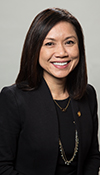
Thanh Dinh, DPM, FACFAS
ACFAS President
It was my dream job. I was working at a major Boston teaching hospital, part of a distinguished medical school and privileged to be teaching medical students and residents. As I walked through the New England fall foliage on my way into the hospital surrounded by the grandeur of the medical buildings, I would pinch myself to make sure this was all real. I loved my work.
It started off with small events. During rounds, I would be singled out by patients for requests or water and other mundane tasks and often ignored by the other care teams. I was often mistaken for a resident trainee or medical student, but I laughed off these moments, blaming my diminutive size and youthful appearance.
Until that day.
He was a new patient and as soon as I walked into the exam room, declared he needed surgery. As we started to discuss his symptoms, he abruptly stopped me, looked at me full in the face and yelled “I want to see a real doctor, not some Chinese girl!” I think I stammered out the words that in fact, I was Vietnamese, but this did nothing to quell his rage and anger. He grabbed his coat, glared at me, and stormed out of the room.
I sat in silence for a few minutes, trying to stop shaking and reviewing the exact words that came out of my mouth to possibly have triggered his response. During that day and the days to follow, I would often dissect the interaction, thinking of all the ways I could have convinced him I was worthy of being his surgeon.
My enthusiasm for patient care waned. The vigor in my stroll to work felt like an uphill trudge to a place I did not belong, and I felt unwanted, unnecessary and unwelcomed.
In those days, it was difficult to articulate the damage racism and bias could inflict on an individual. Instead, many like myself, internalized the rejection and hurt and ultimately, our passion for our work and patient care suffered. Fortunately, as a society we have bravely focused our attention on the detrimental impact racism and bias can inflict and how embracing diversity and inclusion can positively influence our interactions.
As originally coined by diversity advocate, Verna Myers, “Diversity is being invited to the party; inclusion is being asked to dance.” While this may be an oversimplification, it provides context regarding how we can begin to understand and address these issues in healthcare. Throughout all facets of healthcare, race/ethnicity, gender, sexual orientation, immigration status, physical disability status, socioeconomic level plays a role in representation, acceptance and the sense of belonging.
Espousing diversity in healthcare can lead to cultural competency, the ability of healthcare providers to offer services that meet the unique social, cultural and linguistic needs of their patients. In short, the better a patient is represented and understood, the better they can be treated.
Throughout our daily work, patients and their families put their trust in our hands. And by doing so, they deserve to always be treated with the utmost respect and compassion.
ACFAS members are committed to providing our patients with the highest level of care. To that end, the ACFAS Diversity Equity Inclusion Task Force has provided a framework to support a culture of diversity and inclusion in our organization. Bold initiatives spearheaded by this task force include grass roots efforts of introducing the specialty of foot and ankle surgery to underserved youth, as well as a new leadership initiative program to provide an open door and equal opportunities to underrepresented groups, which will in turn strengthen the cultural competence of our organization.
Let’s dance.
